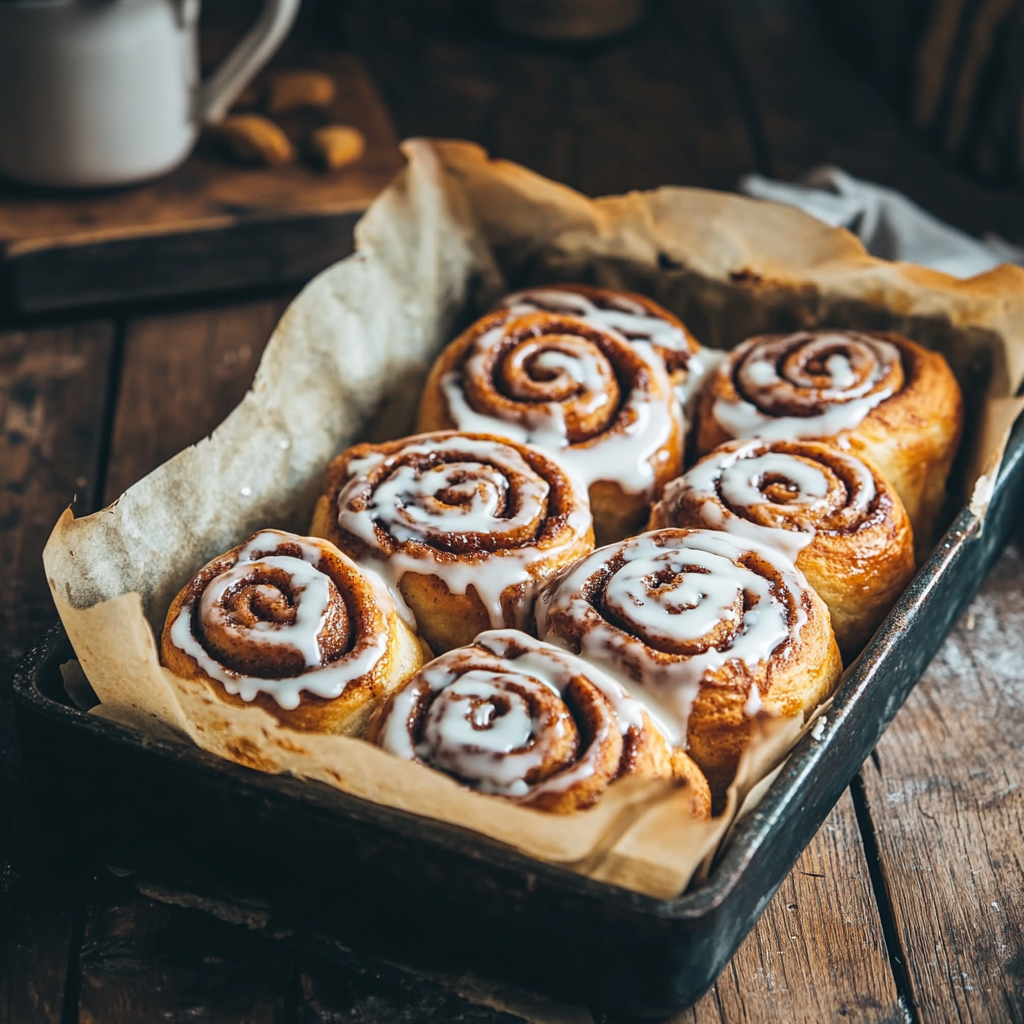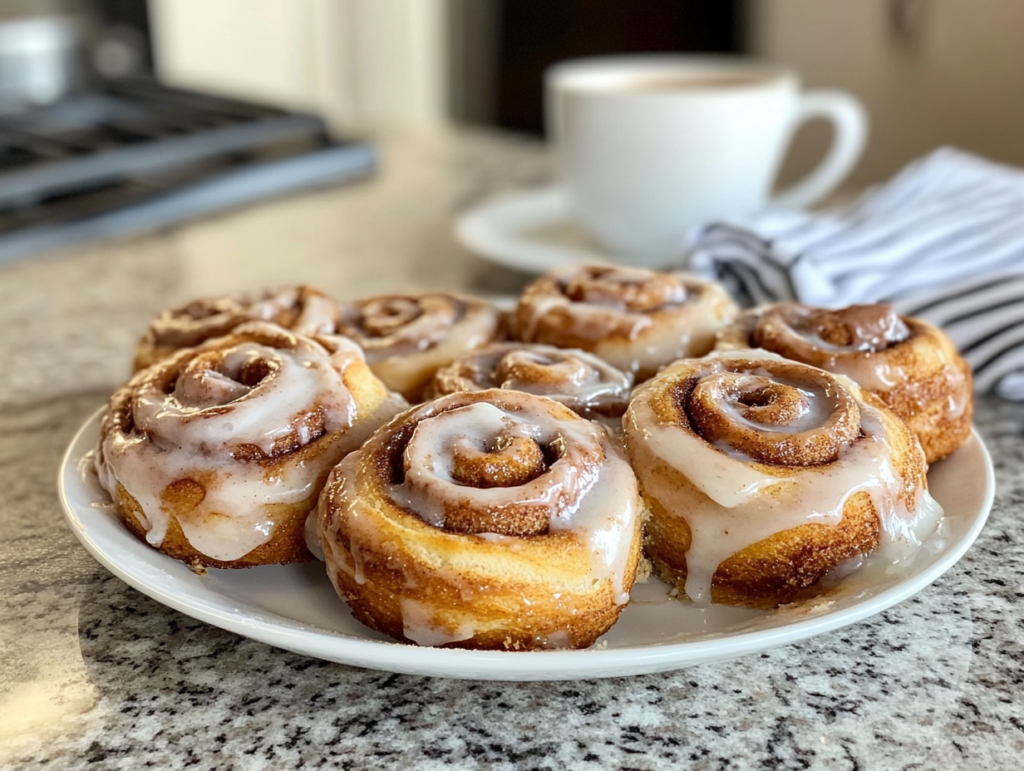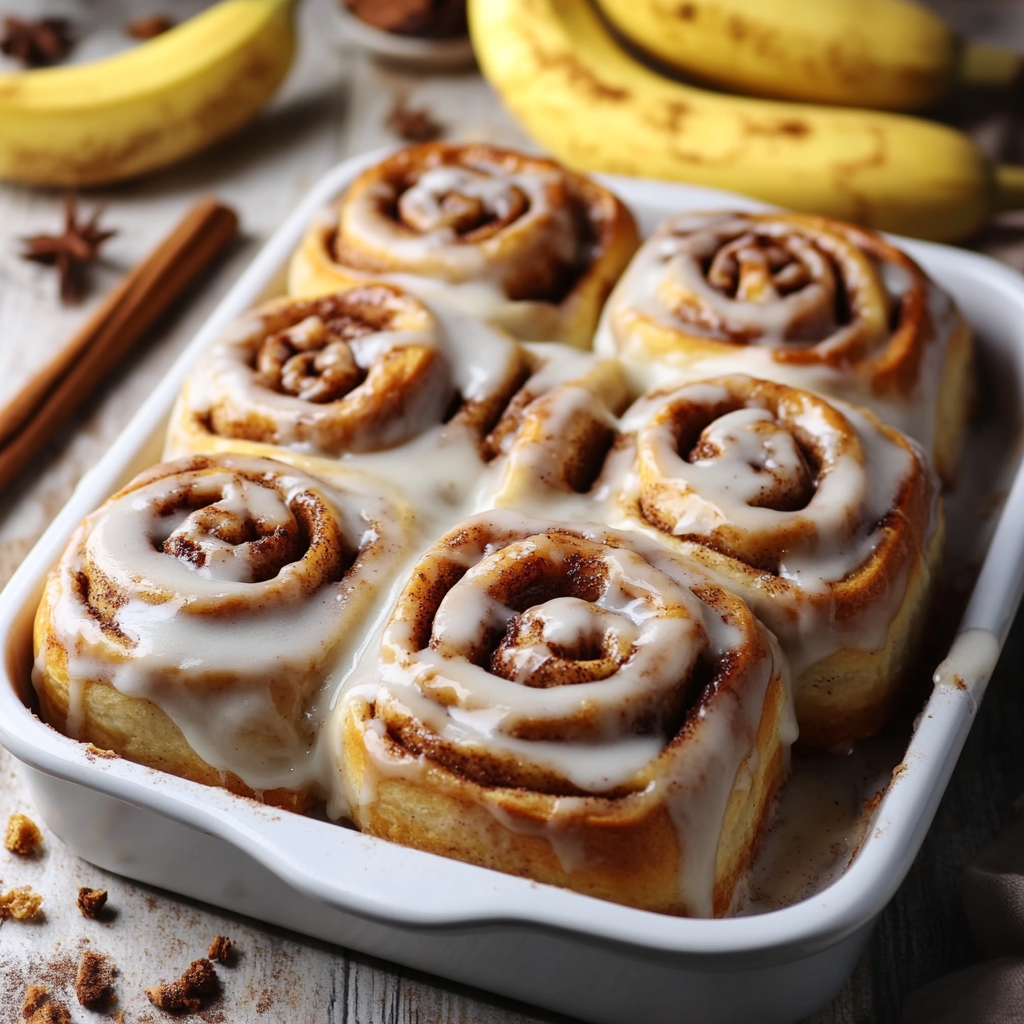
Cinnamon rolls, with their soft, fluffy dough and sweet, spiced filling, have won the hearts of dessert lovers across the globe. These swirled delights are perfect for breakfast, brunch, or dessert, offering an irresistible aroma and taste that captures the comfort of home baking. Originating in Sweden as “kanelbullar,” cinnamon rolls have evolved into a versatile treat enjoyed in countless variations.
In this article, we’ll explore the history of cinnamon rolls, dive into their ingredients, and share tips for making the perfect batch. From classic recipes to innovative twists, there’s something here for every enthusiast to savor.
What Are Cinnamon Rolls?
Cinnamon rolls are a type of sweet pastry made from a soft yeast-leavened dough rolled with a rich cinnamon-sugar filling. They are typically topped with a glaze or frosting, making them both visually appealing and irresistibly delicious. Often enjoyed fresh from the oven, cinnamon rolls embody the perfect balance of tender dough and warm spices.
Key Characteristics of Cinnamon Rolls
- Swirled Appearance: The signature spiral shape, achieved by rolling the dough, is as appealing to the eye as it is to the taste buds.
- Soft, Fluffy Texture: A well-made cinnamon roll is light and airy, thanks to the yeast-leavened dough.
- Sweet and Spiced Filling: Cinnamon, sugar, and sometimes butter are layered inside, providing a warm, aromatic flavor.
- Icing or Glaze: A final drizzle of icing, typically made from powdered sugar, milk, and vanilla, adds a sweet finish.
The History of Cinnamon Rolls
The origins of cinnamon rolls can be traced back to Sweden, where they are known as “kanelbullar.” These rolls became an integral part of Scandinavian cuisine and were celebrated as a special treat on occasions like “Kanelbullens Dag” (Cinnamon Roll Day) every October 4th.
How Cinnamon Rolls Spread Globally
- European Influence: Swedish immigrants introduced cinnamon rolls to other parts of Europe and North America.
- American Popularity: In the United States, the dessert gained widespread popularity, evolving into a sweeter, richer version with cream cheese frosting.
- Modern Variations: Today, cinnamon rolls come in various flavors and styles, reflecting the culinary influences of different regions.
Key Ingredients and Their Role
The magic of cinnamon rolls lies in their simplicity, with each ingredient playing a crucial role in creating the perfect balance of flavor, texture, and aroma. Here’s a breakdown of the essential components that make cinnamon rolls so irresistible.
Dough
The dough is the foundation of a cinnamon roll. Soft, fluffy, and slightly sweet, it serves as the perfect canvas for the cinnamon-sugar filling. Key ingredients in the dough include:
- Flour: Provides structure and elasticity. All-purpose or bread flour is typically used.
- Yeast: Acts as the leavening agent, creating air bubbles that result in a light, airy texture.
- Milk: Adds moisture and richness, enhancing the softness of the dough.
- Eggs: Contribute to the dough’s tenderness and richness.
- Butter: Provides flavor and a tender crumb.
Cinnamon-Sugar Filling
The filling is what gives cinnamon rolls their distinctive warm, spiced flavor. It’s made by combining:
- Ground Cinnamon: The star ingredient that provides the signature aroma and taste.
- Brown Sugar: Adds sweetness and a hint of caramelized flavor.
- Butter: Acts as a binder and ensures the filling melts into the dough during baking.
Icing or Glaze
The icing is the finishing touch, adding sweetness and visual appeal. Popular options include:
- Classic Glaze: A mixture of powdered sugar, milk, and vanilla extract, drizzled over warm rolls.
- Cream Cheese Frosting: Made with cream cheese, powdered sugar, and butter for a rich and tangy flavor.
The Science Behind the Perfect Roll
Understanding the science behind each step in making cinnamon rolls can help ensure consistent results.
Yeast Fermentation
The yeast in the dough feeds on sugar, producing carbon dioxide that causes the dough to rise. Proper proofing times and warm temperatures are essential to achieve the desired texture.
Dough Elasticity
Kneading the dough develops gluten, a protein that gives the dough its elasticity. This elasticity allows the dough to stretch without tearing when rolled.
Even Baking
To ensure even baking, cinnamon rolls should be arranged closely in a baking pan. This prevents over-browning and helps retain moisture.
Step-by-Step Guide to Making Cinnamon Rolls
Making cinnamon rolls from scratch is a rewarding experience that fills your home with the warm, comforting aroma of cinnamon and freshly baked dough. Follow this detailed guide to create perfect cinnamon rolls.

Ingredients
the Dough:
- 4 cups all-purpose flour
- 1 packet (2 ¼ tsp) active dry yeast
- 1 cup warm milk (110°F/45°C)
- 1/3 cup granulated sugar
- 1/3 cup unsalted butter, melted
- 1 tsp salt
- 2 large eggs
the Filling:
- 1/2 cup unsalted butter, softened
- 1 cup brown sugar
- 2 tbsp ground cinnamon
For the Glaze:
- 1 cup powdered sugar
- 2 tbsp milk
- 1 tsp vanilla extract
Preparing the Dough
- Activate the Yeast: In a small bowl, combine warm milk and a teaspoon of sugar. Sprinkle the yeast on top, stir gently, and let it sit for 5–10 minutes until frothy. This indicates the yeast is active.
- Mix Wet Ingredients: In a large mixing bowl, whisk together melted butter, sugar, eggs, and the activated yeast mixture.
- Combine with Dry Ingredients: Gradually add flour and salt to the wet mixture, stirring with a spoon or using a stand mixer with a dough hook. Continue mixing until a sticky dough forms.
- Knead the Dough: Transfer the dough to a floured surface and knead for 8–10 minutes until smooth and elastic. If using a mixer, knead for about 5 minutes on medium speed.
- First Proofing: Place the dough in a greased bowl, cover with a clean kitchen towel, and let it rise in a warm place for 1–2 hours, or until it doubles in size.
Making the Filling
- In a small bowl, mix the brown sugar and cinnamon until evenly combined.
- Ensure the butter is softened to a spreadable consistency for easy application.
Assembling the Rolls
- Roll Out the Dough: Once the dough has risen, punch it down to release air. Roll it out on a floured surface into a rectangle approximately 18×12 inches.
- Spread the Filling: Evenly spread softened butter over the dough. Sprinkle the cinnamon-sugar mixture on top, ensuring full coverage.
- Roll the Dough: Starting from the long edge, roll the dough tightly into a log. Pinch the seam to seal.
- Cut the Rolls: Using a sharp knife or floss, slice the log into 12 equal pieces. Place the rolls in a greased baking dish, leaving a small gap between each.
Second Proofing
Cover the rolls with a kitchen towel and let them rise for another 30–45 minutes. They should puff up and fill the gaps in the baking dish.
Baking the Rolls
- Preheat your oven to 375°F (190°C).
- Bake the rolls for 20–25 minutes, or until golden brown. Check for doneness by inserting a toothpick into the center roll—it should come out clean.
Adding the Glaze
- In a bowl, whisk together powdered sugar, milk, and vanilla extract until smooth.
- Drizzle the glaze over the warm rolls, allowing it to melt into the spirals.
Enjoy your freshly baked cinnamon rolls warm, and savor the fruits of your labor! Would you like me to proceed with the next section?
Storing and Reheating Cinnamon Rolls
Properly storing and reheating cinnamon rolls ensures that they retain their soft texture and rich flavor. Whether you’ve made a big batch to enjoy over several days or have leftovers from a bakery, follow these steps to keep them fresh and delicious.
Storing Cinnamon Rolls
At Room Temperature
- Cool Completely: Allow the cinnamon rolls to cool completely after baking. Storing them warm can create condensation, which leads to sogginess.
- Use an Airtight Container: Place the rolls in an airtight container or wrap them tightly with plastic wrap or aluminum foil. This prevents them from drying out.
- Shelf Life: Cinnamon rolls stored at room temperature will stay fresh for up to 2 days.
In the Refrigerator
- Wrap Securely: To avoid moisture loss, wrap individual rolls in plastic wrap and store them in a resealable plastic bag or airtight container.
- Extended Freshness: Rolls kept in the refrigerator can last for 5–7 days.
In the Freezer
- Wrap for Freezing: Individually wrap each roll with plastic wrap, then place them in a freezer-safe bag or container.
- Label and Date: Write the freezing date to keep track of their freshness.
- Freezer Life: Cinnamon rolls can be frozen for up to 3 months without a significant loss of quality.
Reheating Cinnamon Rolls
In the Microwave
- Cover for Moisture: Place a cinnamon roll on a microwave-safe plate. Cover it with a damp paper towel to prevent drying out.
- Heat Briefly: Microwave on medium power for 20–30 seconds. Check and add a few more seconds if needed.
In the Oven
- Preheat the Oven: Set the oven to 350°F (175°C).
- Wrap the Rolls: Wrap cinnamon rolls in aluminum foil to lock in moisture.
- Warm Gently: Heat in the oven for 10–15 minutes, or until warmed through.
From Frozen
- Thaw First: Remove frozen rolls and let them thaw overnight in the refrigerator or for a few hours at room temperature.
- Reheat Using Your Preferred Method: Once thawed, reheat in the microwave or oven as described above.
Tips for Maintaining Freshness
- Add Extra Moisture: Before reheating, brush the rolls with a little milk or melted butter for added moisture and softness.
- Reheat Only Once: Reheating multiple times can make the rolls dry and tough, so warm only the portion you plan to eat.

Cinnamon rolls are a versatile dessert that pairs beautifully with other creative baking inspirations. For instance, if you’re a fan of combining flavors and textures, consider trying banana bread cinnamon rolls, a delightful fusion of two comfort-food classics. These rolls incorporate the moist, sweet richness of banana bread into the soft, spiraled goodness of a cinnamon roll, making every bite a unique treat. Similarly, for a quicker, more portable option, explore banana bread cookies—a chewy, flavorful twist on traditional banana bread that’s perfect for snacking or gifting. Whether you’re experimenting with banana-inspired recipes or perfecting your cinnamon rolls, there’s always room for creativity in the kitchen!
FAQs
Can I combine cinnamon rolls with banana bread flavors?
Absolutely! Combining cinnamon rolls with banana bread creates a rich and flavorful treat. This fusion merges the soft, fluffy texture with the sweet, moist essence of banana bread for a unique twist.
What are banana bread cookies, and how do they differ from cinnamon rolls?
Banana bread cookies are a bite-sized, chewy take on traditional banana bread, perfect for quick snacks. Unlike cinnamon rolls, they don’t require yeast or rolling, making them a faster and simpler dessert option.
Are there other desserts similar to cinnamon rolls?
Yes, there are plenty of desserts with similar warm and comforting qualities. Variations include sticky buns, which are coated in caramel, or monkey bread, a pull-apart pastry coated in cinnamon sugar. You can also experiment with adding banana-inspired flavors for a unique twist.
Can banana bread flavors work in cookies and rolls?
Definitely! Banana bread’s moist texture and sweet flavor work well in various baked goods. From cookies for on-the-go treats to cinnamon roll-inspired creations for indulgent breakfasts, there are endless ways to incorporate banana bread into your baking.
How do I make my cinnamon rolls more unique?
To make them stand out, consider adding complementary flavors like banana bread to the dough or filling. This small addition can elevate your rolls to a whole new level of flavor and appeal.
Conclusion
Cinnamon rolls are more than just a pastry; they represent warmth, creativity, and the joy of homemade baking. From their classic origins to innovative twists like incorporating banana bread flavors, these sweet, spiraled treats offer endless possibilities for indulgence. Whether enjoyed fresh out of the oven for breakfast or as a comforting dessert, cinnamon rolls have a timeless appeal that brings people together. Furthermore, their versatility ensures they remain a favorite among bakers and dessert lovers alike.
With the insights and tips shared in this guide, you’re well-equipped to craft your own perfect batch. To start, experiment with flavors to make them unique and exciting. Additionally, take time to embrace the process of baking, as it brings both a sense of accomplishment and joy. Moreover, create moments of delight to share with family and friends, as cinnamon rolls are best enjoyed in good company. After all, nothing says love quite like the aroma of freshly baked cinnamon rolls wafting through your home!
